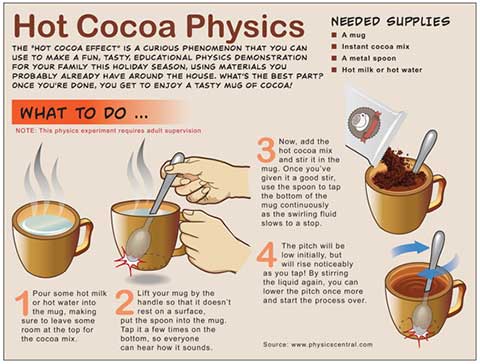Instant Physics: The Hot Cocoa Effect
The “Hot Cocoa Effect” is a curious phenomenon that you can use to make a fun, tasty, educational physics demonstration for your family this holiday season, using materials you probably already have around the house. The best part? Once you're done, you get to enjoy a tasty mug of hot cocoa!
Note: This physics experiment requires adult supervision
All You'll Need Is:
- A mug
- Instant cocoa mix
- A metal spoon
- Hot milk or hot water
What to Do
Pour some hot milk or hot water into the mug, making sure to leave room at the top for the cocoa mix. Lift your mug by the handle so that it doesn’t rest on a surface, put the spoon into the mug, and tap it a few times on the bottom, so everyone can hear what it sounds like. Now, add the cocoa mix and stir it in. Once you’ve given it a good stir, use the spoon to tap the bottom of the mug continuously as the swirling fluid slows to a stop. The pitch will be low initially, but will rise noticeably as you tap! By stirring the liquid again, you can lower the pitch once more and start the process over.

What's Going On?
The pitch that a mug of cocoa produces when it’s tapped depends on the shape of the container and the speed of sound in the cocoa. The shape of the container doesn’t change as you tap, so it must be the speed of sound that’s changing. In fact, the pitch of the tapping is proportional to the speed of sound in the cocoa, so the rising pitch shows that the speed of sound is increasing in the cocoa along with the pitch.
So, why does the speed of sound in cocoa change? It’s because of the bubbles. When you mix cocoa into water or milk, it creates a fine foam made of tiny bubbles on the surface. Vigorous stirring spreads the bubbles throughout the liquid. The bubbles are filled with air, of course, and sound travels much slower through air than through the liquid. Distributing the bubbles in the liquid means the mixture becomes much more compressible, or "springy", which makes the speed of sound lower. When you stop stirring, the bubbles rise to the surface, decreasing the amount of air that the sound of the tapping passes through and increasing the amount of liquid it passes through. As the bubbles float to the top, the speed of sound in the cocoa—along with the pitch produced by tapping—goes up!
Apply It!
Try scooping the layer of foam off the top of your mug before re-stirring it. What do you notice?
-Stephen Skolnick














